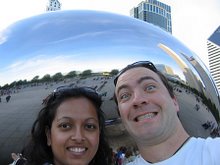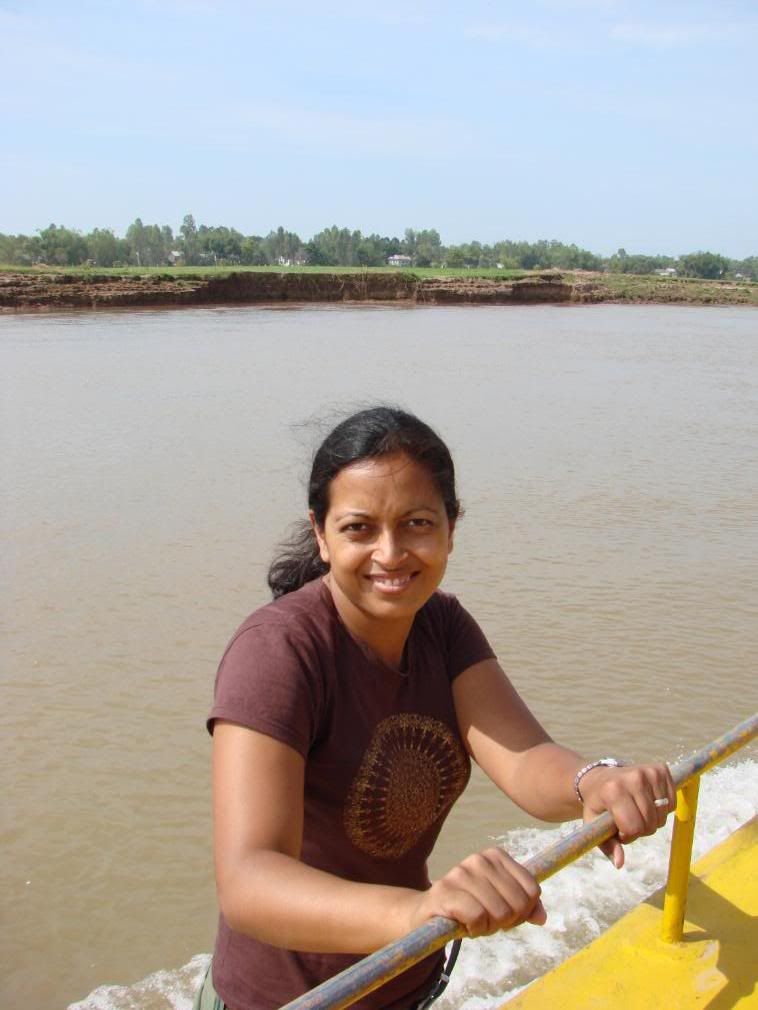 On the way we stopped at an ATM and were pleasantly surprised but slightly disturbed that the currency was U.S. dollars. We strolled along the river, and passed several small temples and dozens of homeless people, mostly children. We also came across "Bug Row", which was a street in the local market that was line with vendors selling all kinds of critters: crickets, tarantulas, grasshoppers, grubs, etc. Jason’s adventurous side came forward but we decided to hold off because we didn’t have the camera with us (and unfornutately never got around to getting a picture).
On the way we stopped at an ATM and were pleasantly surprised but slightly disturbed that the currency was U.S. dollars. We strolled along the river, and passed several small temples and dozens of homeless people, mostly children. We also came across "Bug Row", which was a street in the local market that was line with vendors selling all kinds of critters: crickets, tarantulas, grasshoppers, grubs, etc. Jason’s adventurous side came forward but we decided to hold off because we didn’t have the camera with us (and unfornutately never got around to getting a picture).  As we meandered through the city, we came across the Ministry of Cult and Religions which Jason found an apt coupling since he sees them as the same thing, but we couldn't go inside. For dinner, we enjoyed one of the local specialties, fish alok, which consisted of a mixture of lemongrass and coconut (basically Thai but milder). We also sampled the Ankor Beer, which was pretty good but no Beer Lao.
As we meandered through the city, we came across the Ministry of Cult and Religions which Jason found an apt coupling since he sees them as the same thing, but we couldn't go inside. For dinner, we enjoyed one of the local specialties, fish alok, which consisted of a mixture of lemongrass and coconut (basically Thai but milder). We also sampled the Ankor Beer, which was pretty good but no Beer Lao.The next day we went to the Royal Palace, which was pretty similar to the other palaces we had seen, though there were some highlights. That night, Jason found a poker game full of ex-pats being played at a nearby restaurant. 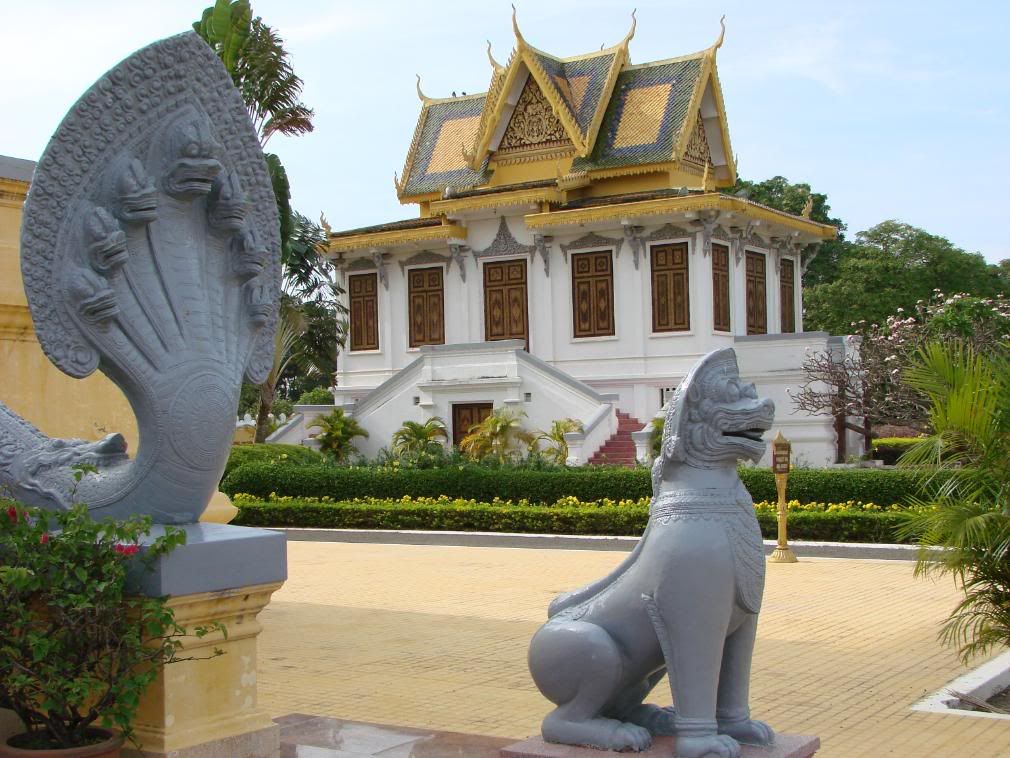 During the game, Jason would get his chance to sample one of the critters as one of the local women dialed in an order for a bag of crickets to go. Ten minutes later, they were sitting in front of him, waiting to be consumed. As he crunched into it, he was reminded of the dried salty sardines we had eaten in the Philippines. Jason managed to win some money despite the chips inexplicably being denominated in kip, the Khmer currency that no one uses except to provide change when less than $1. After collecting his winnings, he decided to head out with a New Yorker named Mark, who’d been living in Phnom Penh for four months. As they conversed, Jason brought up our upcoming travel plans to India, where Mark had spent several months traveling, specifically Ladakh. Jason mentioned that some friends had made a documentary about Buddhist mystics in Ladakh, and it turns out we were separated by just one degree, the inimitable Smitty (Ryan Smith)! We both were in awe as the interconnectedness of our planet planted itself right in our laps. Mark shared some interesting insights into the city which is famous for its lawlessness and frontier zeitgeist (think Wild West).
During the game, Jason would get his chance to sample one of the critters as one of the local women dialed in an order for a bag of crickets to go. Ten minutes later, they were sitting in front of him, waiting to be consumed. As he crunched into it, he was reminded of the dried salty sardines we had eaten in the Philippines. Jason managed to win some money despite the chips inexplicably being denominated in kip, the Khmer currency that no one uses except to provide change when less than $1. After collecting his winnings, he decided to head out with a New Yorker named Mark, who’d been living in Phnom Penh for four months. As they conversed, Jason brought up our upcoming travel plans to India, where Mark had spent several months traveling, specifically Ladakh. Jason mentioned that some friends had made a documentary about Buddhist mystics in Ladakh, and it turns out we were separated by just one degree, the inimitable Smitty (Ryan Smith)! We both were in awe as the interconnectedness of our planet planted itself right in our laps. Mark shared some interesting insights into the city which is famous for its lawlessness and frontier zeitgeist (think Wild West). 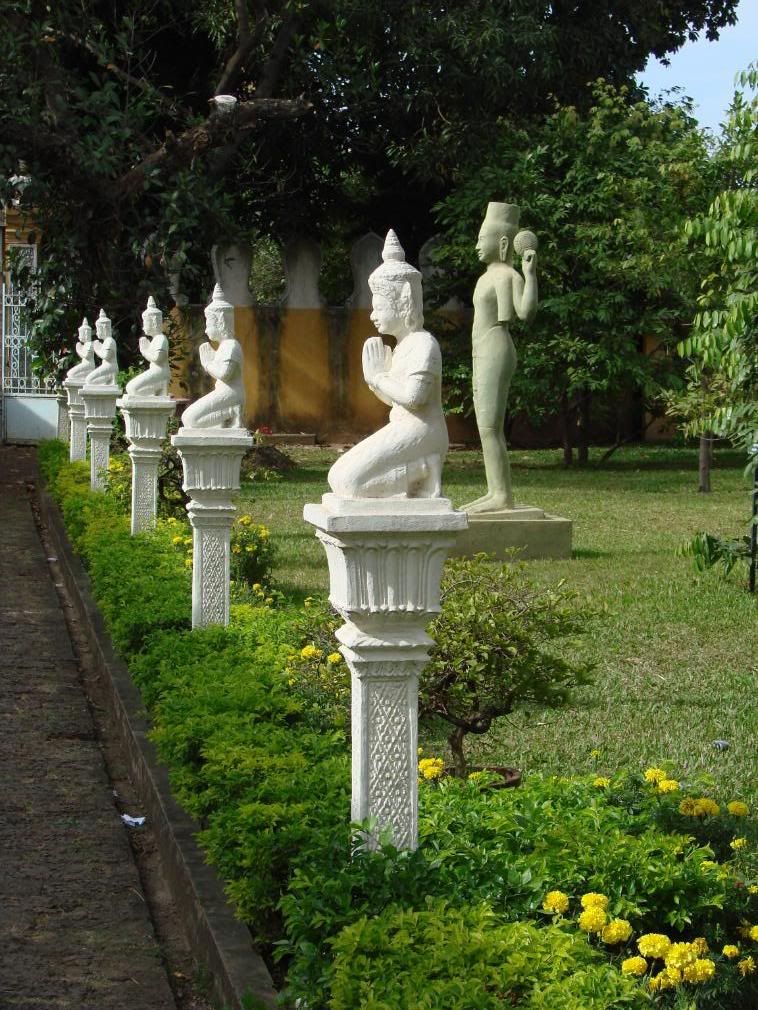 For example, there is one street, which we did not see, that is essentially ‘Prostitute Row’ and is lined with little warehouses filled with girls and boys as young as fourteen that will satisfy even the most depraved tourists. Cambodia is now one of the most popular countries for sex tourism because it is cheaper than Thailand (which is already very cheap) and Vietnam clamped down on the industry; many if not most of the prostitutes working in Cambodia (often having been enslaved) are actually Vietnamese. Jason was barely able to restrain himself when he saw men aged sixty or older holding hands with teenagers. More chillingly, at the hotel at which we were staying, which was huge and packed with backpackers, two tourists had been found dead in their room. Luckily, when we went out to another club, we didn’t witness firsthand this lawlessness and no one pulled their guns out (which is apparently a common occurrence).
For example, there is one street, which we did not see, that is essentially ‘Prostitute Row’ and is lined with little warehouses filled with girls and boys as young as fourteen that will satisfy even the most depraved tourists. Cambodia is now one of the most popular countries for sex tourism because it is cheaper than Thailand (which is already very cheap) and Vietnam clamped down on the industry; many if not most of the prostitutes working in Cambodia (often having been enslaved) are actually Vietnamese. Jason was barely able to restrain himself when he saw men aged sixty or older holding hands with teenagers. More chillingly, at the hotel at which we were staying, which was huge and packed with backpackers, two tourists had been found dead in their room. Luckily, when we went out to another club, we didn’t witness firsthand this lawlessness and no one pulled their guns out (which is apparently a common occurrence).
 During the game, Jason would get his chance to sample one of the critters as one of the local women dialed in an order for a bag of crickets to go. Ten minutes later, they were sitting in front of him, waiting to be consumed. As he crunched into it, he was reminded of the dried salty sardines we had eaten in the Philippines. Jason managed to win some money despite the chips inexplicably being denominated in kip, the Khmer currency that no one uses except to provide change when less than $1. After collecting his winnings, he decided to head out with a New Yorker named Mark, who’d been living in Phnom Penh for four months. As they conversed, Jason brought up our upcoming travel plans to India, where Mark had spent several months traveling, specifically Ladakh. Jason mentioned that some friends had made a documentary about Buddhist mystics in Ladakh, and it turns out we were separated by just one degree, the inimitable Smitty (Ryan Smith)! We both were in awe as the interconnectedness of our planet planted itself right in our laps. Mark shared some interesting insights into the city which is famous for its lawlessness and frontier zeitgeist (think Wild West).
During the game, Jason would get his chance to sample one of the critters as one of the local women dialed in an order for a bag of crickets to go. Ten minutes later, they were sitting in front of him, waiting to be consumed. As he crunched into it, he was reminded of the dried salty sardines we had eaten in the Philippines. Jason managed to win some money despite the chips inexplicably being denominated in kip, the Khmer currency that no one uses except to provide change when less than $1. After collecting his winnings, he decided to head out with a New Yorker named Mark, who’d been living in Phnom Penh for four months. As they conversed, Jason brought up our upcoming travel plans to India, where Mark had spent several months traveling, specifically Ladakh. Jason mentioned that some friends had made a documentary about Buddhist mystics in Ladakh, and it turns out we were separated by just one degree, the inimitable Smitty (Ryan Smith)! We both were in awe as the interconnectedness of our planet planted itself right in our laps. Mark shared some interesting insights into the city which is famous for its lawlessness and frontier zeitgeist (think Wild West).  For example, there is one street, which we did not see, that is essentially ‘Prostitute Row’ and is lined with little warehouses filled with girls and boys as young as fourteen that will satisfy even the most depraved tourists. Cambodia is now one of the most popular countries for sex tourism because it is cheaper than Thailand (which is already very cheap) and Vietnam clamped down on the industry; many if not most of the prostitutes working in Cambodia (often having been enslaved) are actually Vietnamese. Jason was barely able to restrain himself when he saw men aged sixty or older holding hands with teenagers. More chillingly, at the hotel at which we were staying, which was huge and packed with backpackers, two tourists had been found dead in their room. Luckily, when we went out to another club, we didn’t witness firsthand this lawlessness and no one pulled their guns out (which is apparently a common occurrence).
For example, there is one street, which we did not see, that is essentially ‘Prostitute Row’ and is lined with little warehouses filled with girls and boys as young as fourteen that will satisfy even the most depraved tourists. Cambodia is now one of the most popular countries for sex tourism because it is cheaper than Thailand (which is already very cheap) and Vietnam clamped down on the industry; many if not most of the prostitutes working in Cambodia (often having been enslaved) are actually Vietnamese. Jason was barely able to restrain himself when he saw men aged sixty or older holding hands with teenagers. More chillingly, at the hotel at which we were staying, which was huge and packed with backpackers, two tourists had been found dead in their room. Luckily, when we went out to another club, we didn’t witness firsthand this lawlessness and no one pulled their guns out (which is apparently a common occurrence). The following day was a depressing one, as we took a tour into Cambodia’s tragic history. (For those who look at the picture galleries, some are quite disturbing.) We both read a political biography of Pol Pot (Saloth Sar was his real name) called Brother Number One by David Chandler, so we’ll share some of his disturbing life, which is intertwined with Cambodia’s horrific history. Briefly, Pol Pot was a fanatical communist who, through Machiavellian maneuvering, pure charm, and sheer luck became Brother Number One, as he was called by his subordinates. Although he came from a privileged background and even studied abroad in France, he despised the Cambodian leaders, who got themselves into the middle of the conflict between American and Vietnam. Pol Pot and his colleagues also hated both of the parties in this conflict, although they played the Vietnamese Communists in order to win their support. 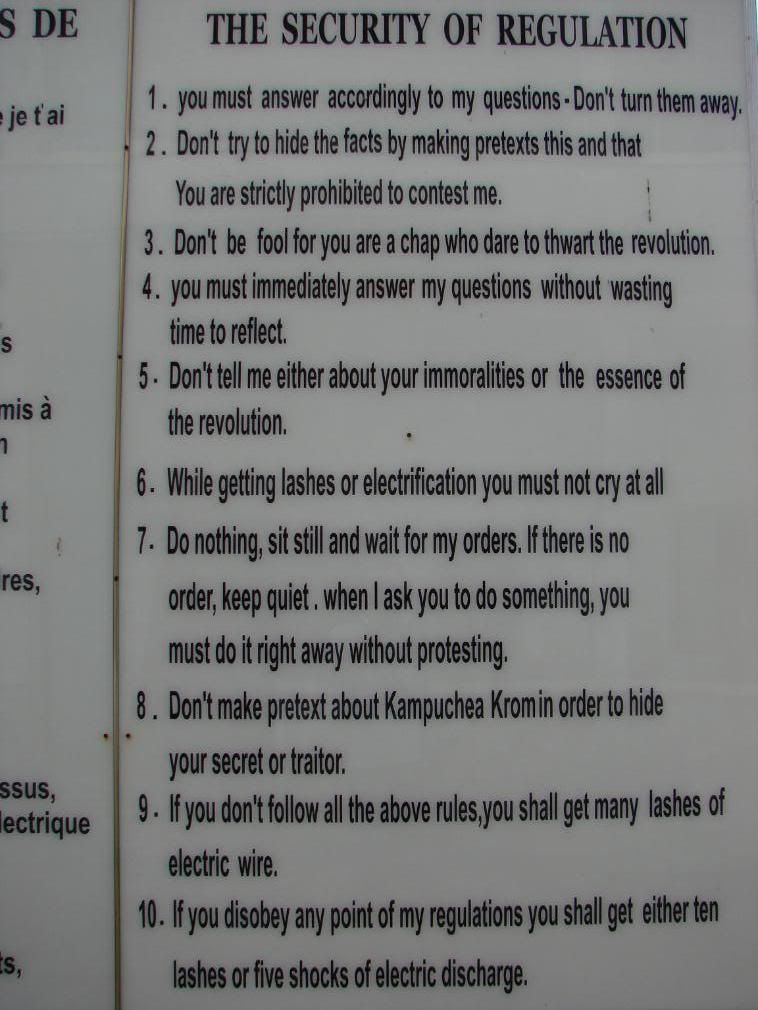 In 1975, upon their relatively easy defeat of the corrupt Sihanouk’s army, Pol Pot and his group of naïve revolutionaries then set about annihilating their country in order to form a Communist utopia. Their first move was to implement an asinine policy of evacuating all of the major cities and forcing literally everyone into the countryside. The rationale for this policy was that for too long city residents had exploited the farmers. Hundreds of thousands died during this phase alone. Those who survived faced in many cases an even worse fate, as they were stripped of all possessions (money was abolished) and forced into the hardest labor imaginable. One of the slogans often heard by these ‘new people,’ as displaced city residents were called, was ‘nothing is gained if you live, nothing is lost if you die.’ Pol Pot’s own paranoia was projected onto the entire country, as everyone was on guard for fear of being reported as a traitor.
In 1975, upon their relatively easy defeat of the corrupt Sihanouk’s army, Pol Pot and his group of naïve revolutionaries then set about annihilating their country in order to form a Communist utopia. Their first move was to implement an asinine policy of evacuating all of the major cities and forcing literally everyone into the countryside. The rationale for this policy was that for too long city residents had exploited the farmers. Hundreds of thousands died during this phase alone. Those who survived faced in many cases an even worse fate, as they were stripped of all possessions (money was abolished) and forced into the hardest labor imaginable. One of the slogans often heard by these ‘new people,’ as displaced city residents were called, was ‘nothing is gained if you live, nothing is lost if you die.’ Pol Pot’s own paranoia was projected onto the entire country, as everyone was on guard for fear of being reported as a traitor. 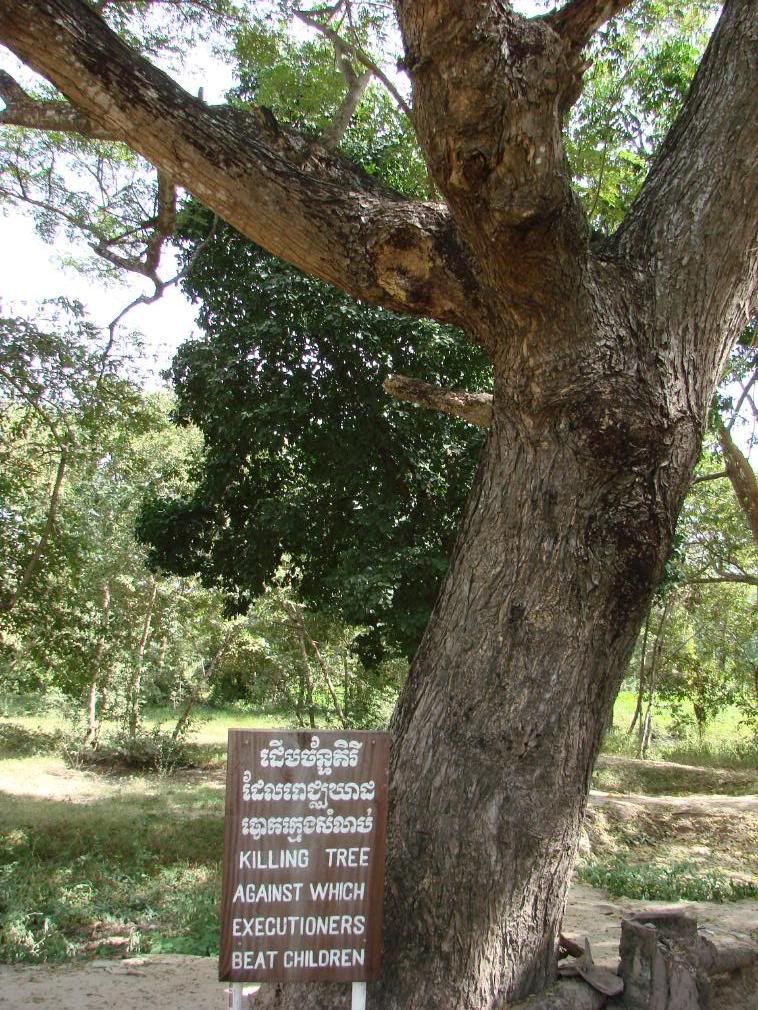 Children were indoctrinated to turn on their parents and even knowing someone who was suspected of minor wrongdoings was punishable by torture and death. Two years into their power, they ignited a full-on war with Vietnam that would ultimately destroy their regime two years later. Although they spent just four years in power, the Khmer Rouge were directly responsible for the deaths of over 1 million people, or about 1/7 of their population.
Children were indoctrinated to turn on their parents and even knowing someone who was suspected of minor wrongdoings was punishable by torture and death. Two years into their power, they ignited a full-on war with Vietnam that would ultimately destroy their regime two years later. Although they spent just four years in power, the Khmer Rouge were directly responsible for the deaths of over 1 million people, or about 1/7 of their population.
 In 1975, upon their relatively easy defeat of the corrupt Sihanouk’s army, Pol Pot and his group of naïve revolutionaries then set about annihilating their country in order to form a Communist utopia. Their first move was to implement an asinine policy of evacuating all of the major cities and forcing literally everyone into the countryside. The rationale for this policy was that for too long city residents had exploited the farmers. Hundreds of thousands died during this phase alone. Those who survived faced in many cases an even worse fate, as they were stripped of all possessions (money was abolished) and forced into the hardest labor imaginable. One of the slogans often heard by these ‘new people,’ as displaced city residents were called, was ‘nothing is gained if you live, nothing is lost if you die.’ Pol Pot’s own paranoia was projected onto the entire country, as everyone was on guard for fear of being reported as a traitor.
In 1975, upon their relatively easy defeat of the corrupt Sihanouk’s army, Pol Pot and his group of naïve revolutionaries then set about annihilating their country in order to form a Communist utopia. Their first move was to implement an asinine policy of evacuating all of the major cities and forcing literally everyone into the countryside. The rationale for this policy was that for too long city residents had exploited the farmers. Hundreds of thousands died during this phase alone. Those who survived faced in many cases an even worse fate, as they were stripped of all possessions (money was abolished) and forced into the hardest labor imaginable. One of the slogans often heard by these ‘new people,’ as displaced city residents were called, was ‘nothing is gained if you live, nothing is lost if you die.’ Pol Pot’s own paranoia was projected onto the entire country, as everyone was on guard for fear of being reported as a traitor.  Children were indoctrinated to turn on their parents and even knowing someone who was suspected of minor wrongdoings was punishable by torture and death. Two years into their power, they ignited a full-on war with Vietnam that would ultimately destroy their regime two years later. Although they spent just four years in power, the Khmer Rouge were directly responsible for the deaths of over 1 million people, or about 1/7 of their population.
Children were indoctrinated to turn on their parents and even knowing someone who was suspected of minor wrongdoings was punishable by torture and death. Two years into their power, they ignited a full-on war with Vietnam that would ultimately destroy their regime two years later. Although they spent just four years in power, the Khmer Rouge were directly responsible for the deaths of over 1 million people, or about 1/7 of their population. First, we visited the killing fields, about 10 kms outside of town, which was the location for much of the genocide that transpired. We saw a gut-wrenching memorial that was seven stories high and filled with victims’ skulls, organized into demographic groups. Thus, there was one shelf filled with children’s remains. A haunting music filled the room and neither of us had dry eyes when we left. As we walked around the fields, there were dug out pits where hundreds of corpses had been found, and a tree where victims were slammed against it to preserve bullets because the army couldn’t afford them.  The next stop was Tuol Sleng, or S-21, which was a school that the Khmer Rouge turned into a prison. One three-story building consisted of a series of cells. On the first floor, each room had a single bed in the middle with various implements of torture chained to them. Graphic pictures on the wall showed the corpses that were left to rot in those very same beds. The 2nd and 3rd stories contained smaller cells that were about the size of closets, where other victims were held. The adjacent building contained room after room of portraits of the victims. We slowly moved through these rooms, entranced by the expressions on their faces: fear, resignation, anger, even hope that they might be spared. But of the more than 14,000 residents of S-21, there were just seven survivors. The faces of the child victims were the saddest of all.
The next stop was Tuol Sleng, or S-21, which was a school that the Khmer Rouge turned into a prison. One three-story building consisted of a series of cells. On the first floor, each room had a single bed in the middle with various implements of torture chained to them. Graphic pictures on the wall showed the corpses that were left to rot in those very same beds. The 2nd and 3rd stories contained smaller cells that were about the size of closets, where other victims were held. The adjacent building contained room after room of portraits of the victims. We slowly moved through these rooms, entranced by the expressions on their faces: fear, resignation, anger, even hope that they might be spared. But of the more than 14,000 residents of S-21, there were just seven survivors. The faces of the child victims were the saddest of all. One fascinating aspect of the Khmer Rouge is that they maintained copious records of their victims, including lengthy confessions (some over 200 pages) that were generally extracted by torture. The most informative confessions were from Pol Pot’s inner circle, over half of whom were ultimately purged, even though some of them had been his ‘friends’ for two decades. Somehow, Pol Pot escaped death and lived in hiding and then house arrest until his death in 1998. Astoundingly, based on his comments shortly before his death, ‘everything I did, I did for my country,’ his conscience remained clear. But what’s even more astounding is that, according to Mark, the Khmer Rouge are still in power in much of the more remote areas of Cambodia.
One fascinating aspect of the Khmer Rouge is that they maintained copious records of their victims, including lengthy confessions (some over 200 pages) that were generally extracted by torture. The most informative confessions were from Pol Pot’s inner circle, over half of whom were ultimately purged, even though some of them had been his ‘friends’ for two decades. Somehow, Pol Pot escaped death and lived in hiding and then house arrest until his death in 1998. Astoundingly, based on his comments shortly before his death, ‘everything I did, I did for my country,’ his conscience remained clear. But what’s even more astounding is that, according to Mark, the Khmer Rouge are still in power in much of the more remote areas of Cambodia.
 The next stop was Tuol Sleng, or S-21, which was a school that the Khmer Rouge turned into a prison. One three-story building consisted of a series of cells. On the first floor, each room had a single bed in the middle with various implements of torture chained to them. Graphic pictures on the wall showed the corpses that were left to rot in those very same beds. The 2nd and 3rd stories contained smaller cells that were about the size of closets, where other victims were held. The adjacent building contained room after room of portraits of the victims. We slowly moved through these rooms, entranced by the expressions on their faces: fear, resignation, anger, even hope that they might be spared. But of the more than 14,000 residents of S-21, there were just seven survivors. The faces of the child victims were the saddest of all.
The next stop was Tuol Sleng, or S-21, which was a school that the Khmer Rouge turned into a prison. One three-story building consisted of a series of cells. On the first floor, each room had a single bed in the middle with various implements of torture chained to them. Graphic pictures on the wall showed the corpses that were left to rot in those very same beds. The 2nd and 3rd stories contained smaller cells that were about the size of closets, where other victims were held. The adjacent building contained room after room of portraits of the victims. We slowly moved through these rooms, entranced by the expressions on their faces: fear, resignation, anger, even hope that they might be spared. But of the more than 14,000 residents of S-21, there were just seven survivors. The faces of the child victims were the saddest of all. One fascinating aspect of the Khmer Rouge is that they maintained copious records of their victims, including lengthy confessions (some over 200 pages) that were generally extracted by torture. The most informative confessions were from Pol Pot’s inner circle, over half of whom were ultimately purged, even though some of them had been his ‘friends’ for two decades. Somehow, Pol Pot escaped death and lived in hiding and then house arrest until his death in 1998. Astoundingly, based on his comments shortly before his death, ‘everything I did, I did for my country,’ his conscience remained clear. But what’s even more astounding is that, according to Mark, the Khmer Rouge are still in power in much of the more remote areas of Cambodia.
One fascinating aspect of the Khmer Rouge is that they maintained copious records of their victims, including lengthy confessions (some over 200 pages) that were generally extracted by torture. The most informative confessions were from Pol Pot’s inner circle, over half of whom were ultimately purged, even though some of them had been his ‘friends’ for two decades. Somehow, Pol Pot escaped death and lived in hiding and then house arrest until his death in 1998. Astoundingly, based on his comments shortly before his death, ‘everything I did, I did for my country,’ his conscience remained clear. But what’s even more astounding is that, according to Mark, the Khmer Rouge are still in power in much of the more remote areas of Cambodia.After such a sad day, we decided to try some of the "happy" pizza that Phnom Penh is known for. While we waited for our order, some of the pirated-book-vendors approached our table, none of them older than 12. Although Jason had agreed not to buy any books (we had too many already), he was about to buy two more about Cambodia when Priti became very agitated and started yelling at him. After a few tense and awkward minutes, the girl left. Later, as we were enjoying our pizza, another girl came by and mysteriously dropped a copy of The Motorcycle Diaries by Che Guevara on our table and said "Merry Christmas." On the inside cover was the following inscription:
THANKS FOR BEING AN A**HOLE AMERICAN AND MAKING A FOOL OF YOURSELF.
GET A LIFE.
YOU’RE AN EMBARASSMENT TO THE REST OF US. HERE’S A FREE BOOK FOR YOU SINCE THESE GIRLS ARE SUCH A TERRIBLE INCONVENIENCE AND NUISANCE TO YOU.
MERRY CHRISTMAS.
Jason started laughing hysterically but Priti attempted to rip the cover off before coming around and having a good laugh herself as our dinner lightened up the mood. We ended up buying a few books from her the following day and everyone was happy.
Our next stop was Siem Reap, and we were very glad we had booked a room ahead, as the scene when we got off the bus was insane. There were about 30 touts shouting and shoving fliers into our faces for their hotels and we were thankful we had already booked a room. Siem Reap is the home of Angkor Wat, a massive complex of Hindu ruins from the twelfth century, which comprise the largest temple in the world, spanning about 100 square miles. 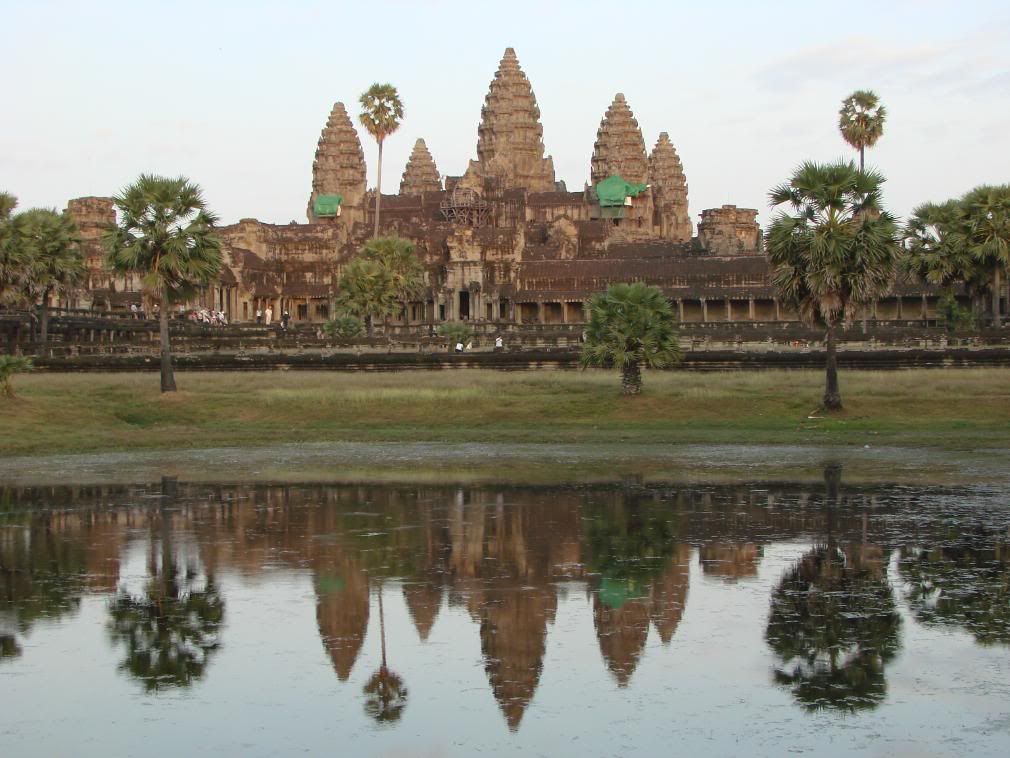 We opted for the three-day pass, which was a bit pricey at $40 but we knew that one day would not be enough and we wanted to take a relaxed pace rather than rush around trying to see everything. Upon our arrival, we purchased a guidebook called Ancient Angkor that we found invaluable in our explorations. Our first stop was Angkor Wat itself; with its triumvirate towers, it is the most well-known of the temples and is a ubiquitous symbol in the Khmer landscape, donning both the flag and the beer.
We opted for the three-day pass, which was a bit pricey at $40 but we knew that one day would not be enough and we wanted to take a relaxed pace rather than rush around trying to see everything. Upon our arrival, we purchased a guidebook called Ancient Angkor that we found invaluable in our explorations. Our first stop was Angkor Wat itself; with its triumvirate towers, it is the most well-known of the temples and is a ubiquitous symbol in the Khmer landscape, donning both the flag and the beer. 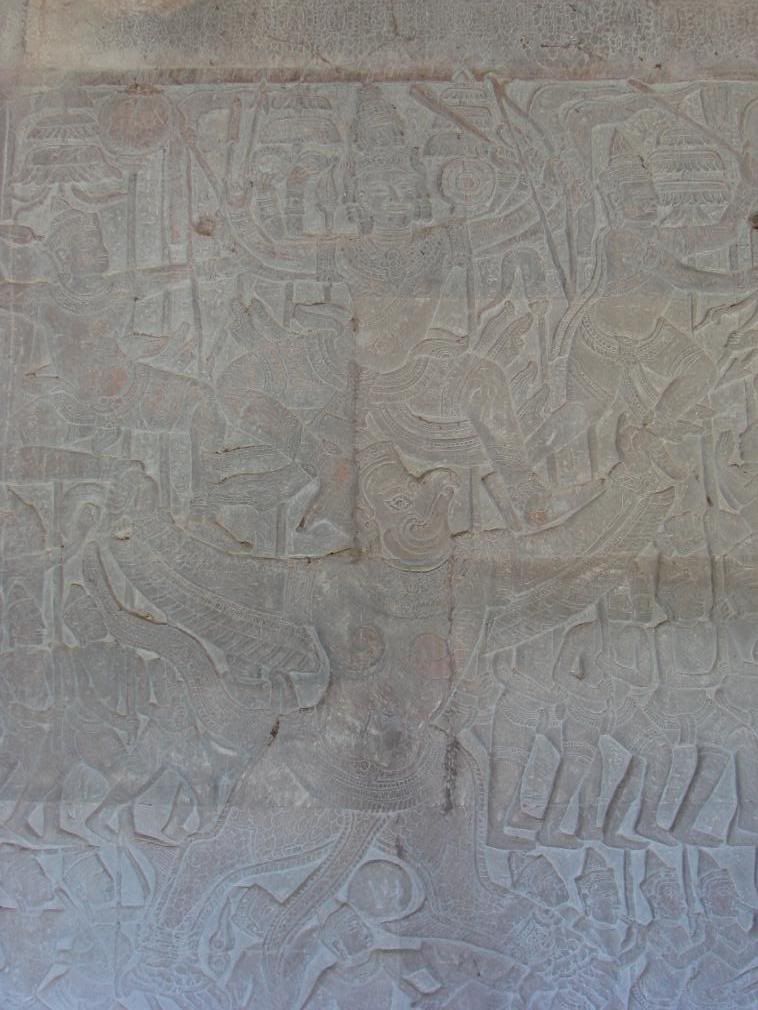 It is truly an amazing structure to behold and one of the most amazing things we’ve ever seen. Pol Pot was reported to have said, when informed that his production goals were impossible to meet, ‘if our people were capable of Angkor, we can do anything.’ Our amazement only grew when we entered the temple, as every wall was covered with detailed carvings called bas-reliefs. Most of the scenes were from Hindu mythology, including the Ramayana and Mahabharata.
It is truly an amazing structure to behold and one of the most amazing things we’ve ever seen. Pol Pot was reported to have said, when informed that his production goals were impossible to meet, ‘if our people were capable of Angkor, we can do anything.’ Our amazement only grew when we entered the temple, as every wall was covered with detailed carvings called bas-reliefs. Most of the scenes were from Hindu mythology, including the Ramayana and Mahabharata.
 We opted for the three-day pass, which was a bit pricey at $40 but we knew that one day would not be enough and we wanted to take a relaxed pace rather than rush around trying to see everything. Upon our arrival, we purchased a guidebook called Ancient Angkor that we found invaluable in our explorations. Our first stop was Angkor Wat itself; with its triumvirate towers, it is the most well-known of the temples and is a ubiquitous symbol in the Khmer landscape, donning both the flag and the beer.
We opted for the three-day pass, which was a bit pricey at $40 but we knew that one day would not be enough and we wanted to take a relaxed pace rather than rush around trying to see everything. Upon our arrival, we purchased a guidebook called Ancient Angkor that we found invaluable in our explorations. Our first stop was Angkor Wat itself; with its triumvirate towers, it is the most well-known of the temples and is a ubiquitous symbol in the Khmer landscape, donning both the flag and the beer.  It is truly an amazing structure to behold and one of the most amazing things we’ve ever seen. Pol Pot was reported to have said, when informed that his production goals were impossible to meet, ‘if our people were capable of Angkor, we can do anything.’ Our amazement only grew when we entered the temple, as every wall was covered with detailed carvings called bas-reliefs. Most of the scenes were from Hindu mythology, including the Ramayana and Mahabharata.
It is truly an amazing structure to behold and one of the most amazing things we’ve ever seen. Pol Pot was reported to have said, when informed that his production goals were impossible to meet, ‘if our people were capable of Angkor, we can do anything.’ Our amazement only grew when we entered the temple, as every wall was covered with detailed carvings called bas-reliefs. Most of the scenes were from Hindu mythology, including the Ramayana and Mahabharata. After spending a few hours wandering through Angkor Wat, we headed to Bayon and its many faces carved right into the stones. As incredible as the main temple was, Bayon was even better. 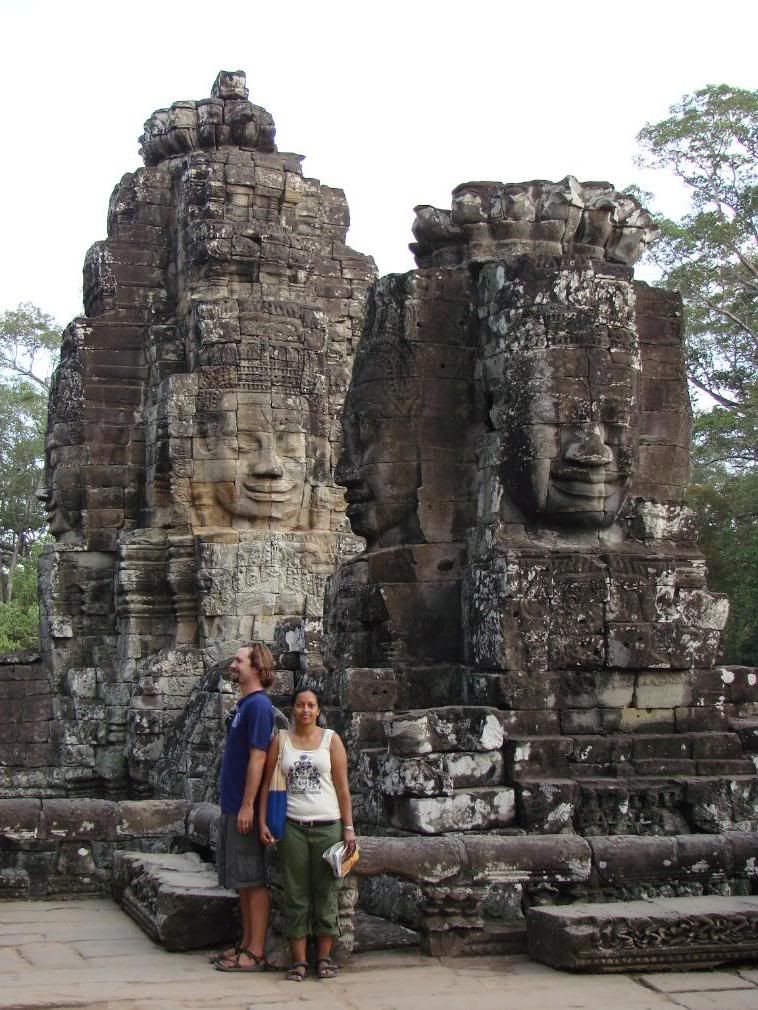 We lost count of the faces whose eyes seemed to follow us throughout the temple. We spent a couple more hours there and before we knew it the day was nearly over. For sunset, we reluctantly opted to join the crowds that gather each evening at a hilltop temple. On our way we stopped at both the Elephant and Leper King Terraces. After ascending the big hill, we had to climb up these huge steps that were so steep we had to use our hands.
We lost count of the faces whose eyes seemed to follow us throughout the temple. We spent a couple more hours there and before we knew it the day was nearly over. For sunset, we reluctantly opted to join the crowds that gather each evening at a hilltop temple. On our way we stopped at both the Elephant and Leper King Terraces. After ascending the big hill, we had to climb up these huge steps that were so steep we had to use our hands. 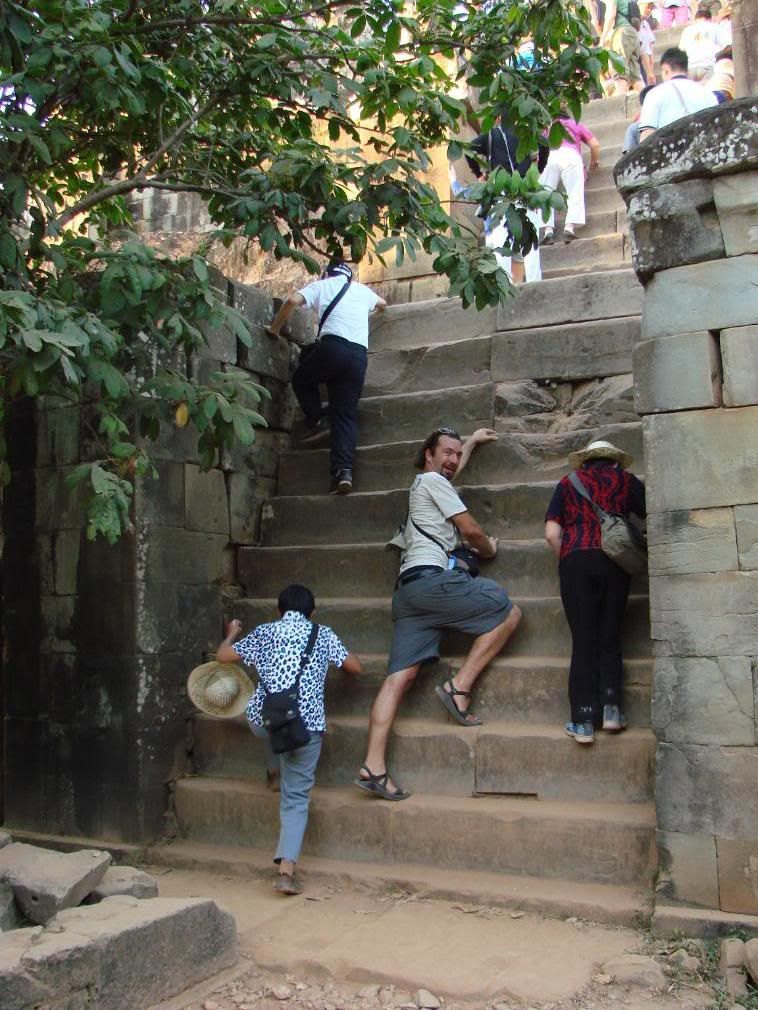 The sun setting behind the temple was nice and we got a good view of Angkor Wat from afar.
The sun setting behind the temple was nice and we got a good view of Angkor Wat from afar.
So ended our first day.  We lost count of the faces whose eyes seemed to follow us throughout the temple. We spent a couple more hours there and before we knew it the day was nearly over. For sunset, we reluctantly opted to join the crowds that gather each evening at a hilltop temple. On our way we stopped at both the Elephant and Leper King Terraces. After ascending the big hill, we had to climb up these huge steps that were so steep we had to use our hands.
We lost count of the faces whose eyes seemed to follow us throughout the temple. We spent a couple more hours there and before we knew it the day was nearly over. For sunset, we reluctantly opted to join the crowds that gather each evening at a hilltop temple. On our way we stopped at both the Elephant and Leper King Terraces. After ascending the big hill, we had to climb up these huge steps that were so steep we had to use our hands.  The sun setting behind the temple was nice and we got a good view of Angkor Wat from afar.
The sun setting behind the temple was nice and we got a good view of Angkor Wat from afar. Feeling lazy, we again hired a tuk-tuk to take us to the temples, and we ventured out to Banteay Srei which was 28 kilometers away from the other temples. It was absolutely worth the one hour tuk-tuk ride since it was beautiful, detailed, and well maintained. And there weren’t many people there. 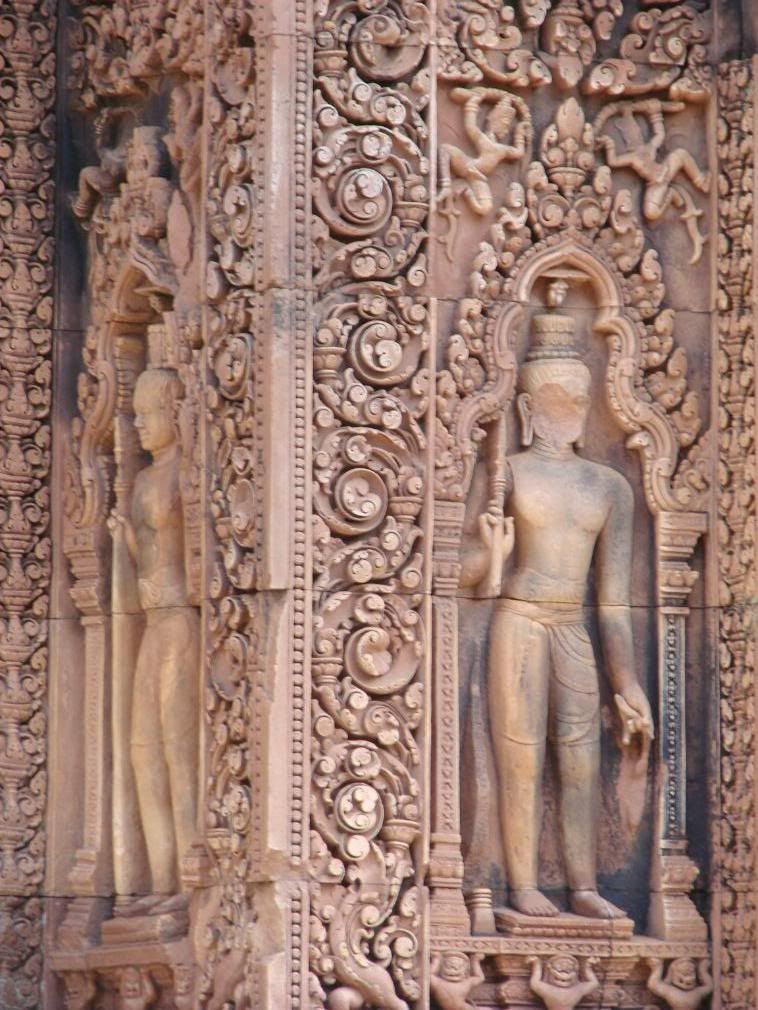 Along the way, we passed many villages, some of which had signs documenting some sort of adoption program by foreigners, most of whom were Americans. It was sad to see yet again dozens of beggin children, and as we were walking to one of the temples, one of them approached us so we gave some of our bananas to her. We hadn’t finished eating the remaining half when another girl approached us. When we offered her bananas, she exclaimed, "I’m not a monkey"(!) Needless to say, she went away empty-handed.
Along the way, we passed many villages, some of which had signs documenting some sort of adoption program by foreigners, most of whom were Americans. It was sad to see yet again dozens of beggin children, and as we were walking to one of the temples, one of them approached us so we gave some of our bananas to her. We hadn’t finished eating the remaining half when another girl approached us. When we offered her bananas, she exclaimed, "I’m not a monkey"(!) Needless to say, she went away empty-handed.
 Along the way, we passed many villages, some of which had signs documenting some sort of adoption program by foreigners, most of whom were Americans. It was sad to see yet again dozens of beggin children, and as we were walking to one of the temples, one of them approached us so we gave some of our bananas to her. We hadn’t finished eating the remaining half when another girl approached us. When we offered her bananas, she exclaimed, "I’m not a monkey"(!) Needless to say, she went away empty-handed.
Along the way, we passed many villages, some of which had signs documenting some sort of adoption program by foreigners, most of whom were Americans. It was sad to see yet again dozens of beggin children, and as we were walking to one of the temples, one of them approached us so we gave some of our bananas to her. We hadn’t finished eating the remaining half when another girl approached us. When we offered her bananas, she exclaimed, "I’m not a monkey"(!) Needless to say, she went away empty-handed.We returned to Bayon temple for sunset and marveled at how the giant faces slightly changed color as the sky got darker. We decided that we would wake up at 5am the next morning in order to see the sunrise at Angkor Wat, which is apparently the time for the best views of the temples. We rented bikes the night before and had a Cambodian barbeque dinner, including kangaroo (yum), cobra (yuk), crocodile (eh), chicken, and pork. 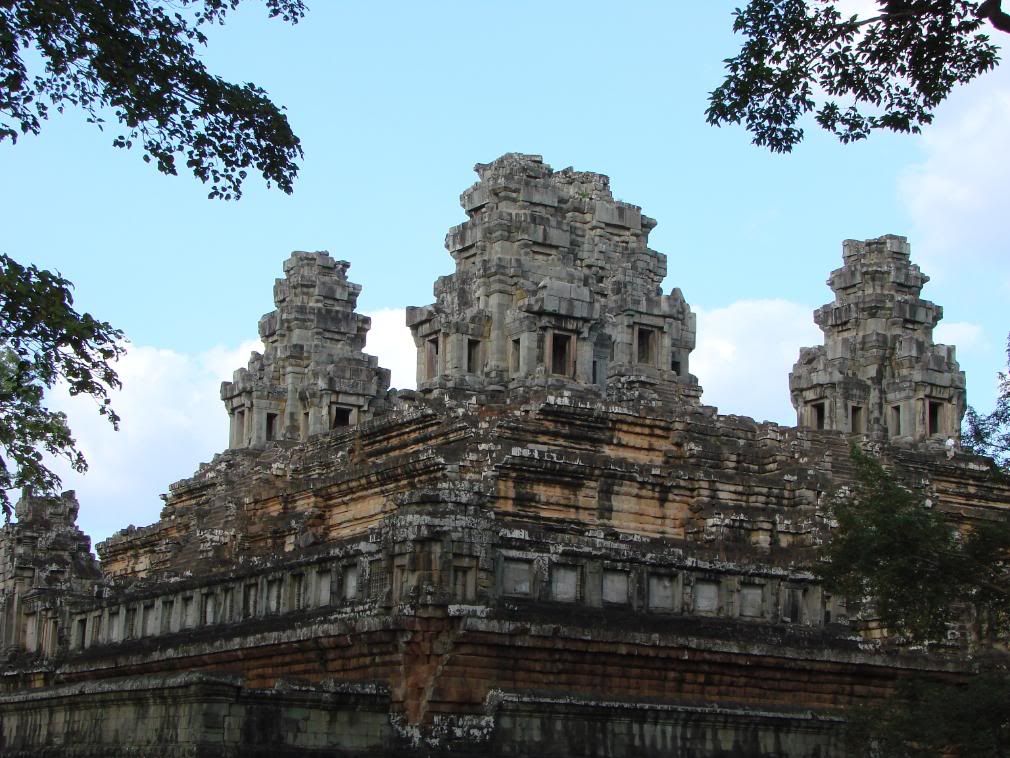 The center of the silver grill had a slab of lard on it which melted and marinated the meat surrounding it. The barbeque was silver and dome shaped so that the meat could be on it. We also enjoyed some Beer Lao and then biked home at a reasonable hour yet we somehow didn’t go to bed until close to midnight. Thus, when the alarm sounded at 5am, we were too tired to get out of bed and ride our bikes to see the sunrise. We got up around eight instead and got ready for a leisurely day of biking. We noticed a wrench on Jason’s bike, which was parked in front of the guesthouse, and then he realized the seat position was lower and the seat had mysteriously suffered a broken shock, making it very uncomfortable to ride. Actually it wasn’t much of a mystery as we knew the seat had been replaced with a broken one. We talked to the guesthouse manager who said the wrench was his but wasn’t sure what had happened to the seat.
The center of the silver grill had a slab of lard on it which melted and marinated the meat surrounding it. The barbeque was silver and dome shaped so that the meat could be on it. We also enjoyed some Beer Lao and then biked home at a reasonable hour yet we somehow didn’t go to bed until close to midnight. Thus, when the alarm sounded at 5am, we were too tired to get out of bed and ride our bikes to see the sunrise. We got up around eight instead and got ready for a leisurely day of biking. We noticed a wrench on Jason’s bike, which was parked in front of the guesthouse, and then he realized the seat position was lower and the seat had mysteriously suffered a broken shock, making it very uncomfortable to ride. Actually it wasn’t much of a mystery as we knew the seat had been replaced with a broken one. We talked to the guesthouse manager who said the wrench was his but wasn’t sure what had happened to the seat. 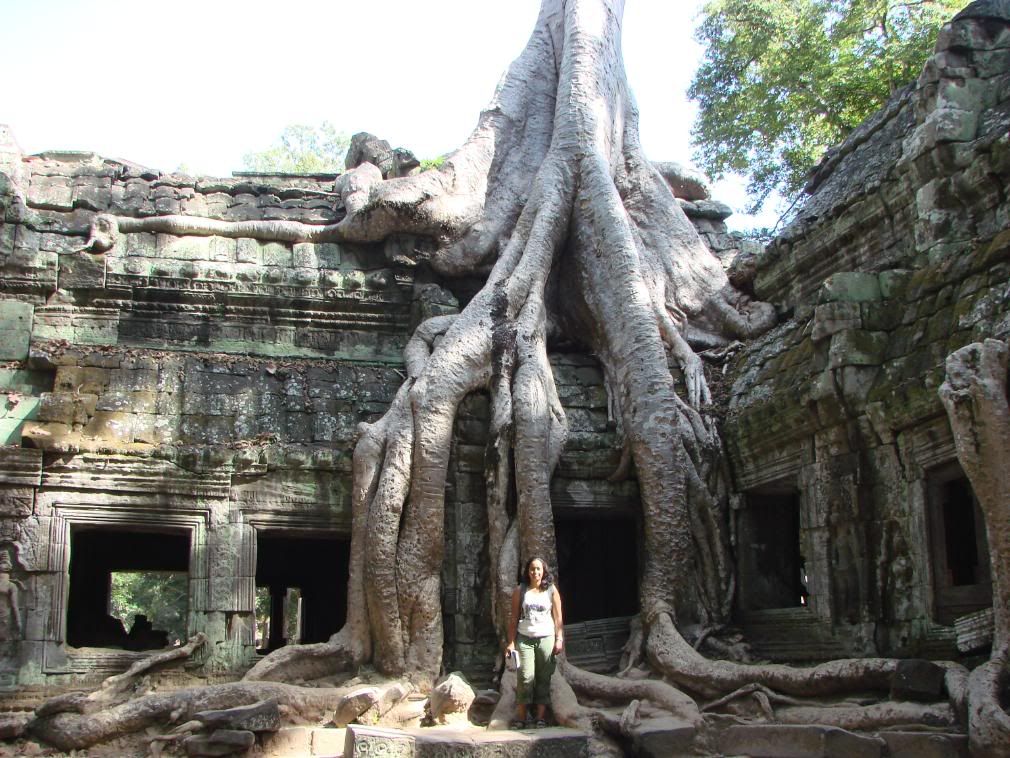 Fortunately we got a replacement without any hassle and then rode off to the Wats. It was a beautiful day with clear skies and a nice wind that kept us cool. This continued the pattern that every time we rent bikes we have great days. The highlight of the day was Ta Prohm, which had lots of trees growing right out of the ruins. At the same time, we were disappointed that some of the temples were in pretty bad shape, considering how much revenue is received each year from tourism. It was even more frustrating because we had received false information that the Temples were owned by the Vietnamese! That evening, we had planned to cap our stay in Siem Reap with a classical music concert that is held at the local children’s hospital every Saturday night. However, when we showed the guesthouse manager the flier, he informed us that it was actually Sunday. This means we had been off by a day for the past week…doh!
Fortunately we got a replacement without any hassle and then rode off to the Wats. It was a beautiful day with clear skies and a nice wind that kept us cool. This continued the pattern that every time we rent bikes we have great days. The highlight of the day was Ta Prohm, which had lots of trees growing right out of the ruins. At the same time, we were disappointed that some of the temples were in pretty bad shape, considering how much revenue is received each year from tourism. It was even more frustrating because we had received false information that the Temples were owned by the Vietnamese! That evening, we had planned to cap our stay in Siem Reap with a classical music concert that is held at the local children’s hospital every Saturday night. However, when we showed the guesthouse manager the flier, he informed us that it was actually Sunday. This means we had been off by a day for the past week…doh!
 The center of the silver grill had a slab of lard on it which melted and marinated the meat surrounding it. The barbeque was silver and dome shaped so that the meat could be on it. We also enjoyed some Beer Lao and then biked home at a reasonable hour yet we somehow didn’t go to bed until close to midnight. Thus, when the alarm sounded at 5am, we were too tired to get out of bed and ride our bikes to see the sunrise. We got up around eight instead and got ready for a leisurely day of biking. We noticed a wrench on Jason’s bike, which was parked in front of the guesthouse, and then he realized the seat position was lower and the seat had mysteriously suffered a broken shock, making it very uncomfortable to ride. Actually it wasn’t much of a mystery as we knew the seat had been replaced with a broken one. We talked to the guesthouse manager who said the wrench was his but wasn’t sure what had happened to the seat.
The center of the silver grill had a slab of lard on it which melted and marinated the meat surrounding it. The barbeque was silver and dome shaped so that the meat could be on it. We also enjoyed some Beer Lao and then biked home at a reasonable hour yet we somehow didn’t go to bed until close to midnight. Thus, when the alarm sounded at 5am, we were too tired to get out of bed and ride our bikes to see the sunrise. We got up around eight instead and got ready for a leisurely day of biking. We noticed a wrench on Jason’s bike, which was parked in front of the guesthouse, and then he realized the seat position was lower and the seat had mysteriously suffered a broken shock, making it very uncomfortable to ride. Actually it wasn’t much of a mystery as we knew the seat had been replaced with a broken one. We talked to the guesthouse manager who said the wrench was his but wasn’t sure what had happened to the seat.  Fortunately we got a replacement without any hassle and then rode off to the Wats. It was a beautiful day with clear skies and a nice wind that kept us cool. This continued the pattern that every time we rent bikes we have great days. The highlight of the day was Ta Prohm, which had lots of trees growing right out of the ruins. At the same time, we were disappointed that some of the temples were in pretty bad shape, considering how much revenue is received each year from tourism. It was even more frustrating because we had received false information that the Temples were owned by the Vietnamese! That evening, we had planned to cap our stay in Siem Reap with a classical music concert that is held at the local children’s hospital every Saturday night. However, when we showed the guesthouse manager the flier, he informed us that it was actually Sunday. This means we had been off by a day for the past week…doh!
Fortunately we got a replacement without any hassle and then rode off to the Wats. It was a beautiful day with clear skies and a nice wind that kept us cool. This continued the pattern that every time we rent bikes we have great days. The highlight of the day was Ta Prohm, which had lots of trees growing right out of the ruins. At the same time, we were disappointed that some of the temples were in pretty bad shape, considering how much revenue is received each year from tourism. It was even more frustrating because we had received false information that the Temples were owned by the Vietnamese! That evening, we had planned to cap our stay in Siem Reap with a classical music concert that is held at the local children’s hospital every Saturday night. However, when we showed the guesthouse manager the flier, he informed us that it was actually Sunday. This means we had been off by a day for the past week…doh! The next day we caught the infamous bus from Siem Reap to Bangkok, which is supposedly made deliberately awful by the government and airlines in order to increase demand for flights to/from Bangkok. We thought we had heeded the warnings by pay a little extra for the deluxe A/C bus. The minivan picked us up from our guesthouse and took us to the station where we waited outside for one hour for the big bus to come. When it arrived, the workers took our bags and started loading them into the bus, which confused all of us passengers. The first person to get on showed a look of shock which was followed by a gasp. Stepping on, we looked aghast as the aisles were filled with our bags and we had to climb over the bags or onto the seats in order to get to our seats. We were annoyed that some of the people did not take there shoes off as they climbed over the luggage. 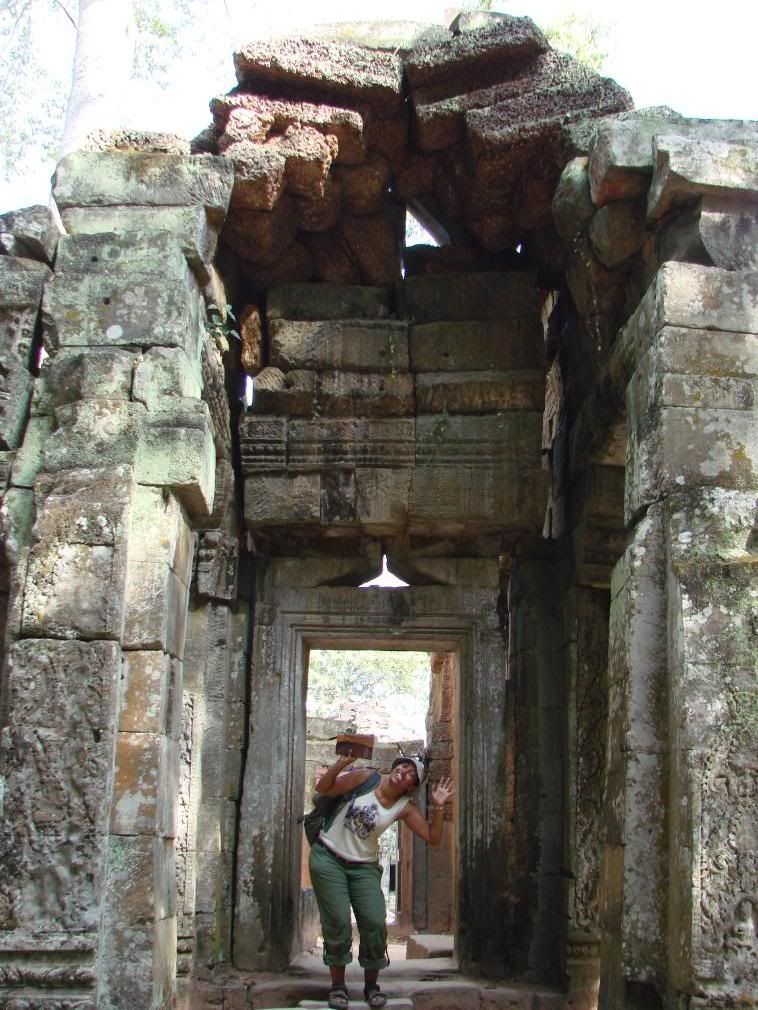 At first, it was just dust on the bags, but after several toilet stops, the dust became mud. The one in the very front got the worst of it, which by the end had a layer of toxic mud caked onto it. Other passengers commented how sorry they felt for the owner who just happened to be Jason. When one young female dolt made the completely asinine and insensitive remark, "I hope no one has anything valuable in their bag" as she proceeded to walk all over them, Jason had to once again summon all his restraint in order not to push her off the bus. At this point Jason would like to mention that he is keeping a record of the most annoying people we’ve met on our trip and she will no doubt occupy a prime spot.
At first, it was just dust on the bags, but after several toilet stops, the dust became mud. The one in the very front got the worst of it, which by the end had a layer of toxic mud caked onto it. Other passengers commented how sorry they felt for the owner who just happened to be Jason. When one young female dolt made the completely asinine and insensitive remark, "I hope no one has anything valuable in their bag" as she proceeded to walk all over them, Jason had to once again summon all his restraint in order not to push her off the bus. At this point Jason would like to mention that he is keeping a record of the most annoying people we’ve met on our trip and she will no doubt occupy a prime spot.
 At first, it was just dust on the bags, but after several toilet stops, the dust became mud. The one in the very front got the worst of it, which by the end had a layer of toxic mud caked onto it. Other passengers commented how sorry they felt for the owner who just happened to be Jason. When one young female dolt made the completely asinine and insensitive remark, "I hope no one has anything valuable in their bag" as she proceeded to walk all over them, Jason had to once again summon all his restraint in order not to push her off the bus. At this point Jason would like to mention that he is keeping a record of the most annoying people we’ve met on our trip and she will no doubt occupy a prime spot.
At first, it was just dust on the bags, but after several toilet stops, the dust became mud. The one in the very front got the worst of it, which by the end had a layer of toxic mud caked onto it. Other passengers commented how sorry they felt for the owner who just happened to be Jason. When one young female dolt made the completely asinine and insensitive remark, "I hope no one has anything valuable in their bag" as she proceeded to walk all over them, Jason had to once again summon all his restraint in order not to push her off the bus. At this point Jason would like to mention that he is keeping a record of the most annoying people we’ve met on our trip and she will no doubt occupy a prime spot.Lo and behold it was the worst bus ride ever. It was very hot and stuffy so people decided to keep the windows open since there was no AC like we had been told. Also, the roads were so dusty that we got covered in a film of dust and could scribble our names on our skin (it ended up taking two washings to get the dust out of our clothes). After five grueling hours, we reached the Cambodia/Thai border and were left to our own devices to cross over, so it took about two hours for everyone to figure it out. 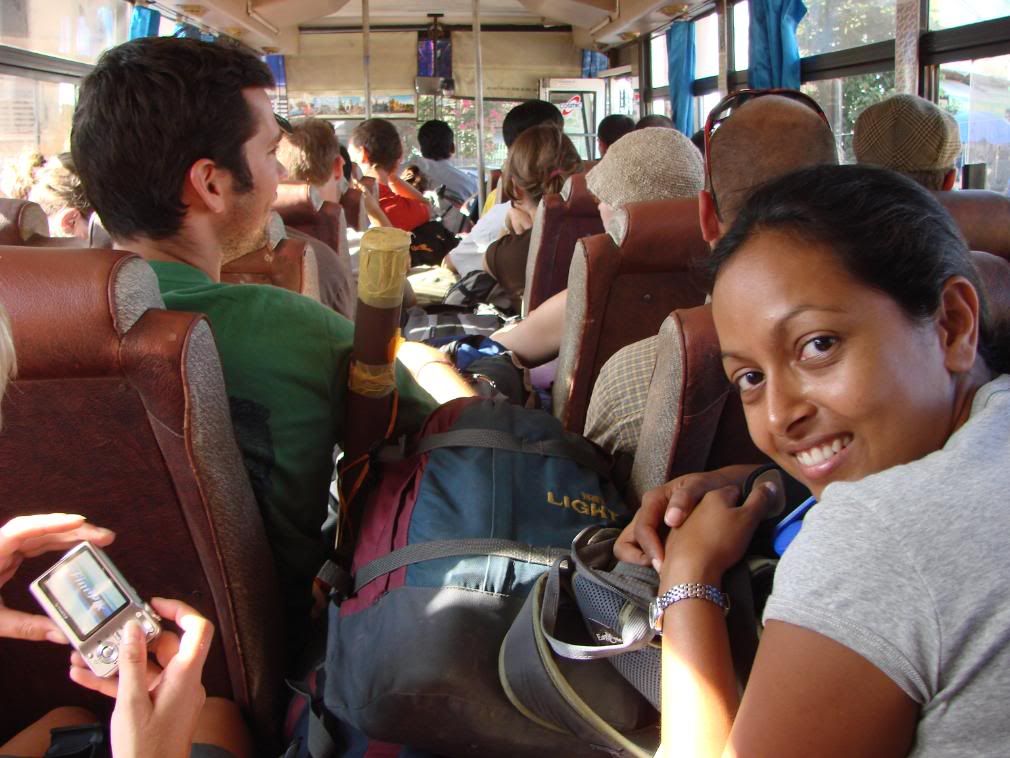 While waiting we watched in disgust as a young boy, probably the age of 5 or 6, was holding a baby strapped to him like a beat up rag-doll. He almost dropped the baby numerous times and his gap-toothed grin seemed to widen with each near drop. Jason wanted to reach out and throttle him but we just had to look the other way. We wondered why these kids didn’t sell bottles of water or something useful instead of just begging for money. After waiting for so long, we were relieved to get onto a bus that actually was air conditioned and drove for 4 more hours to finally reach Bangkok. The total trip took 13 hours but felt like 31 although it could have been worse we figured after seeing this.
While waiting we watched in disgust as a young boy, probably the age of 5 or 6, was holding a baby strapped to him like a beat up rag-doll. He almost dropped the baby numerous times and his gap-toothed grin seemed to widen with each near drop. Jason wanted to reach out and throttle him but we just had to look the other way. We wondered why these kids didn’t sell bottles of water or something useful instead of just begging for money. After waiting for so long, we were relieved to get onto a bus that actually was air conditioned and drove for 4 more hours to finally reach Bangkok. The total trip took 13 hours but felt like 31 although it could have been worse we figured after seeing this.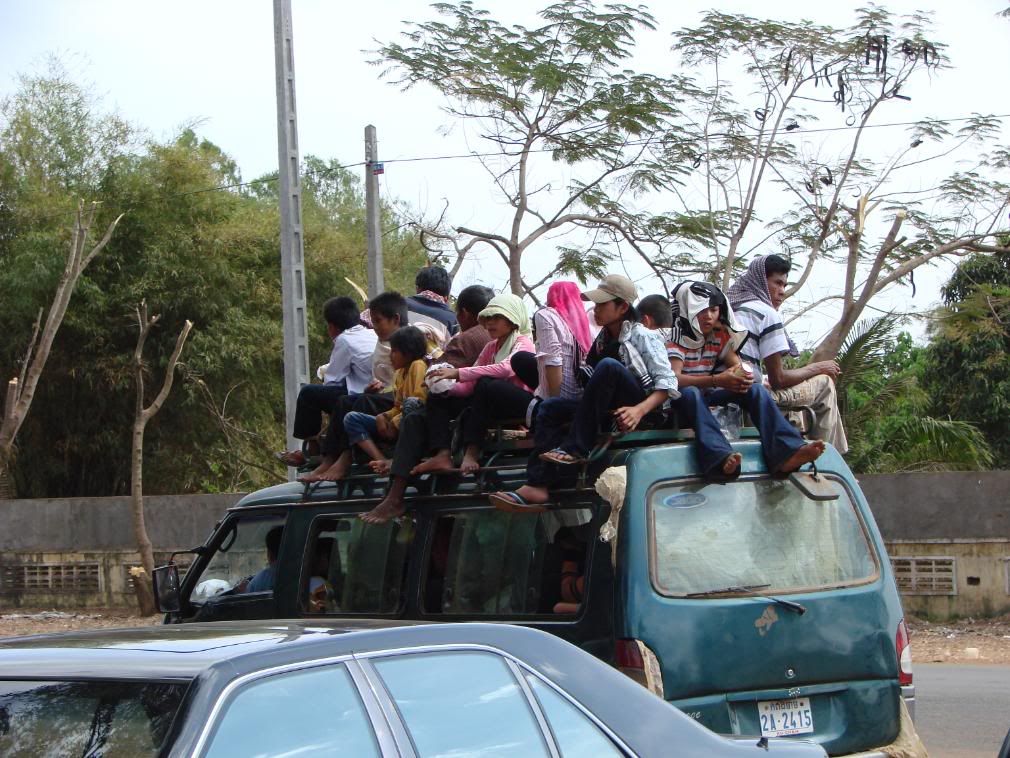 We imagined taking this bus the other way and how awful it must be for people to endure this ride and then be greeted in Cambodia by the insanity at the bus station. Other travelers we’d met had their entire stays in Cambodia ruined because of a negative chain-reaction, like we had experienced in Vietnam. If any of you plan to head to Siem Reap from Thailand, we highly recommend you take the flight rather than risk ruining your entire perceptions of what will hopefully once again be a great country.
We imagined taking this bus the other way and how awful it must be for people to endure this ride and then be greeted in Cambodia by the insanity at the bus station. Other travelers we’d met had their entire stays in Cambodia ruined because of a negative chain-reaction, like we had experienced in Vietnam. If any of you plan to head to Siem Reap from Thailand, we highly recommend you take the flight rather than risk ruining your entire perceptions of what will hopefully once again be a great country.
 While waiting we watched in disgust as a young boy, probably the age of 5 or 6, was holding a baby strapped to him like a beat up rag-doll. He almost dropped the baby numerous times and his gap-toothed grin seemed to widen with each near drop. Jason wanted to reach out and throttle him but we just had to look the other way. We wondered why these kids didn’t sell bottles of water or something useful instead of just begging for money. After waiting for so long, we were relieved to get onto a bus that actually was air conditioned and drove for 4 more hours to finally reach Bangkok. The total trip took 13 hours but felt like 31 although it could have been worse we figured after seeing this.
While waiting we watched in disgust as a young boy, probably the age of 5 or 6, was holding a baby strapped to him like a beat up rag-doll. He almost dropped the baby numerous times and his gap-toothed grin seemed to widen with each near drop. Jason wanted to reach out and throttle him but we just had to look the other way. We wondered why these kids didn’t sell bottles of water or something useful instead of just begging for money. After waiting for so long, we were relieved to get onto a bus that actually was air conditioned and drove for 4 more hours to finally reach Bangkok. The total trip took 13 hours but felt like 31 although it could have been worse we figured after seeing this. We imagined taking this bus the other way and how awful it must be for people to endure this ride and then be greeted in Cambodia by the insanity at the bus station. Other travelers we’d met had their entire stays in Cambodia ruined because of a negative chain-reaction, like we had experienced in Vietnam. If any of you plan to head to Siem Reap from Thailand, we highly recommend you take the flight rather than risk ruining your entire perceptions of what will hopefully once again be a great country.
We imagined taking this bus the other way and how awful it must be for people to endure this ride and then be greeted in Cambodia by the insanity at the bus station. Other travelers we’d met had their entire stays in Cambodia ruined because of a negative chain-reaction, like we had experienced in Vietnam. If any of you plan to head to Siem Reap from Thailand, we highly recommend you take the flight rather than risk ruining your entire perceptions of what will hopefully once again be a great country.Bangkok Redux
Until the week before, we didn’t think we’d be able to meet up with our friends Paul and Sapna, who are also traveling around the world but in the opposite direction (see link in right-hand column). We convinced them to stay at the Merry V hostel, which had been our accommodation during 7 weeks prior. Despite being completely exhausted from the bus trip, our adrenaline kicked in when we saw them sitting outside eating dinner. After freshening up, we shared some of our crazy adventures before heading out to hear some rockin’ live blues music. We had a great time hanging out, and Jason and Sapna managed to see the sunrise after staying out all night. The following night we ate some excellent Thai food and then for desert we sampled some of the local critters. 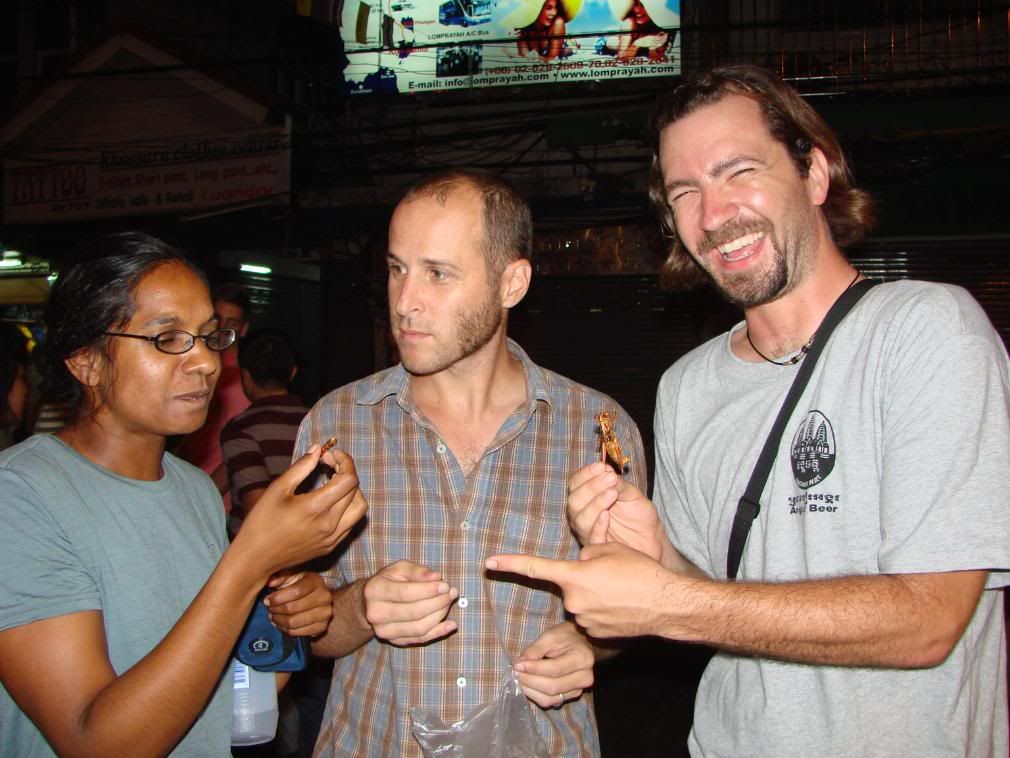 ‘We’ in this instance doesn’t include Priti, as she refused to partake in the exotic snacks. Sapna was enthusiastic but quickly lost it after crunching into her first critter. Jason and Paul chomped on the roasted roaches, grubs and grasshoppers and Jason even got another order of the latter, which he claimed tasted like soy-flavored potato crisps. Also, his distaste for roaches has dissipated since once you’ve eaten them, they lose their gross-out power. J Then we wandered around the area and Jason managed to find a Big Lebowski shirt with a picture of the Dude above the caption ‘The Dude Abides.’ Sapna found it hysterical and had successfully predicted that he would be buying at least one goofy t-shirt in Bangkok. Although we somehow managed not to talk about it, we found out later that they were taken by the same tuk-tuk scammer as us (see Thailand entry)!
‘We’ in this instance doesn’t include Priti, as she refused to partake in the exotic snacks. Sapna was enthusiastic but quickly lost it after crunching into her first critter. Jason and Paul chomped on the roasted roaches, grubs and grasshoppers and Jason even got another order of the latter, which he claimed tasted like soy-flavored potato crisps. Also, his distaste for roaches has dissipated since once you’ve eaten them, they lose their gross-out power. J Then we wandered around the area and Jason managed to find a Big Lebowski shirt with a picture of the Dude above the caption ‘The Dude Abides.’ Sapna found it hysterical and had successfully predicted that he would be buying at least one goofy t-shirt in Bangkok. Although we somehow managed not to talk about it, we found out later that they were taken by the same tuk-tuk scammer as us (see Thailand entry)!
 ‘We’ in this instance doesn’t include Priti, as she refused to partake in the exotic snacks. Sapna was enthusiastic but quickly lost it after crunching into her first critter. Jason and Paul chomped on the roasted roaches, grubs and grasshoppers and Jason even got another order of the latter, which he claimed tasted like soy-flavored potato crisps. Also, his distaste for roaches has dissipated since once you’ve eaten them, they lose their gross-out power. J Then we wandered around the area and Jason managed to find a Big Lebowski shirt with a picture of the Dude above the caption ‘The Dude Abides.’ Sapna found it hysterical and had successfully predicted that he would be buying at least one goofy t-shirt in Bangkok. Although we somehow managed not to talk about it, we found out later that they were taken by the same tuk-tuk scammer as us (see Thailand entry)!
‘We’ in this instance doesn’t include Priti, as she refused to partake in the exotic snacks. Sapna was enthusiastic but quickly lost it after crunching into her first critter. Jason and Paul chomped on the roasted roaches, grubs and grasshoppers and Jason even got another order of the latter, which he claimed tasted like soy-flavored potato crisps. Also, his distaste for roaches has dissipated since once you’ve eaten them, they lose their gross-out power. J Then we wandered around the area and Jason managed to find a Big Lebowski shirt with a picture of the Dude above the caption ‘The Dude Abides.’ Sapna found it hysterical and had successfully predicted that he would be buying at least one goofy t-shirt in Bangkok. Although we somehow managed not to talk about it, we found out later that they were taken by the same tuk-tuk scammer as us (see Thailand entry)!The next morning we said farewell and wished we’d had more time together. Jason, still suffering with respiratory problems that he’d had since climbing Mt. Kinabalu two months earlier, went to the hospital. He unfortunately had bronchitis but once again the Thai medical care proved reliable, albeit not nearly as cheap as Priti’s care in Chiang Mai. 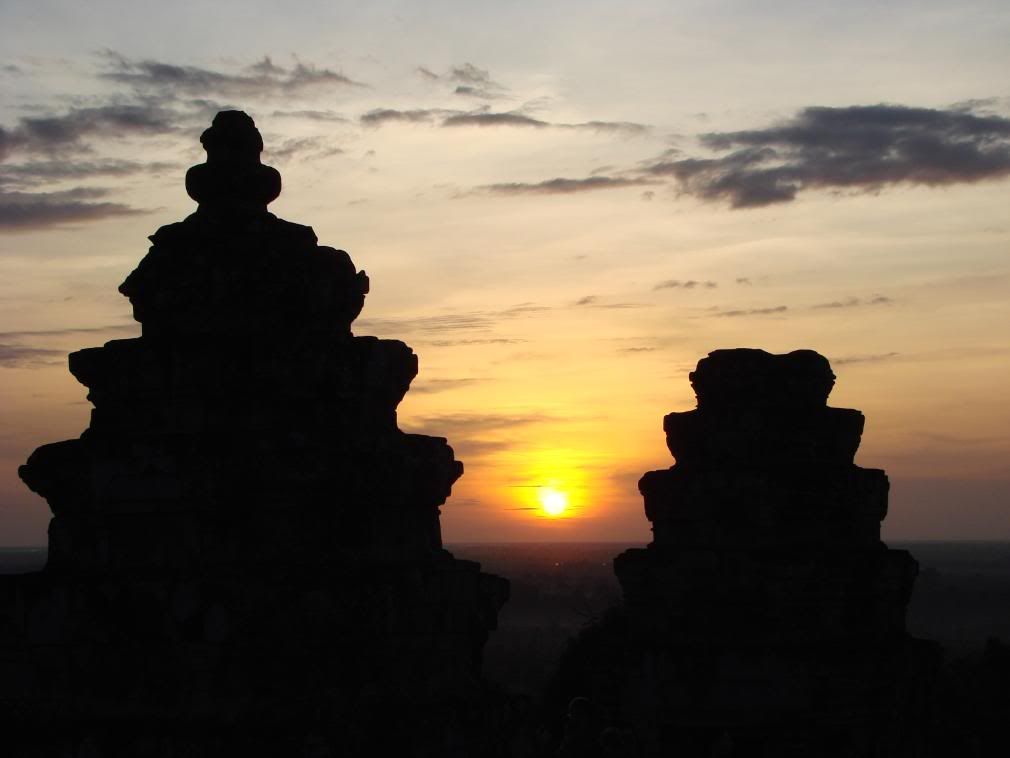 Although we had enjoyed our time in SE Asia, we were ready to move on and are very excited to be heading to our most anticipated destination, the subcontinent of India. (In actuality we have already left India but have had trouble finding high-speed internet to upload our pictures but India updates will be forthcoming very soon; yeah yeah we know you've heard that before).
Although we had enjoyed our time in SE Asia, we were ready to move on and are very excited to be heading to our most anticipated destination, the subcontinent of India. (In actuality we have already left India but have had trouble finding high-speed internet to upload our pictures but India updates will be forthcoming very soon; yeah yeah we know you've heard that before).
 Although we had enjoyed our time in SE Asia, we were ready to move on and are very excited to be heading to our most anticipated destination, the subcontinent of India. (In actuality we have already left India but have had trouble finding high-speed internet to upload our pictures but India updates will be forthcoming very soon; yeah yeah we know you've heard that before).
Although we had enjoyed our time in SE Asia, we were ready to move on and are very excited to be heading to our most anticipated destination, the subcontinent of India. (In actuality we have already left India but have had trouble finding high-speed internet to upload our pictures but India updates will be forthcoming very soon; yeah yeah we know you've heard that before).